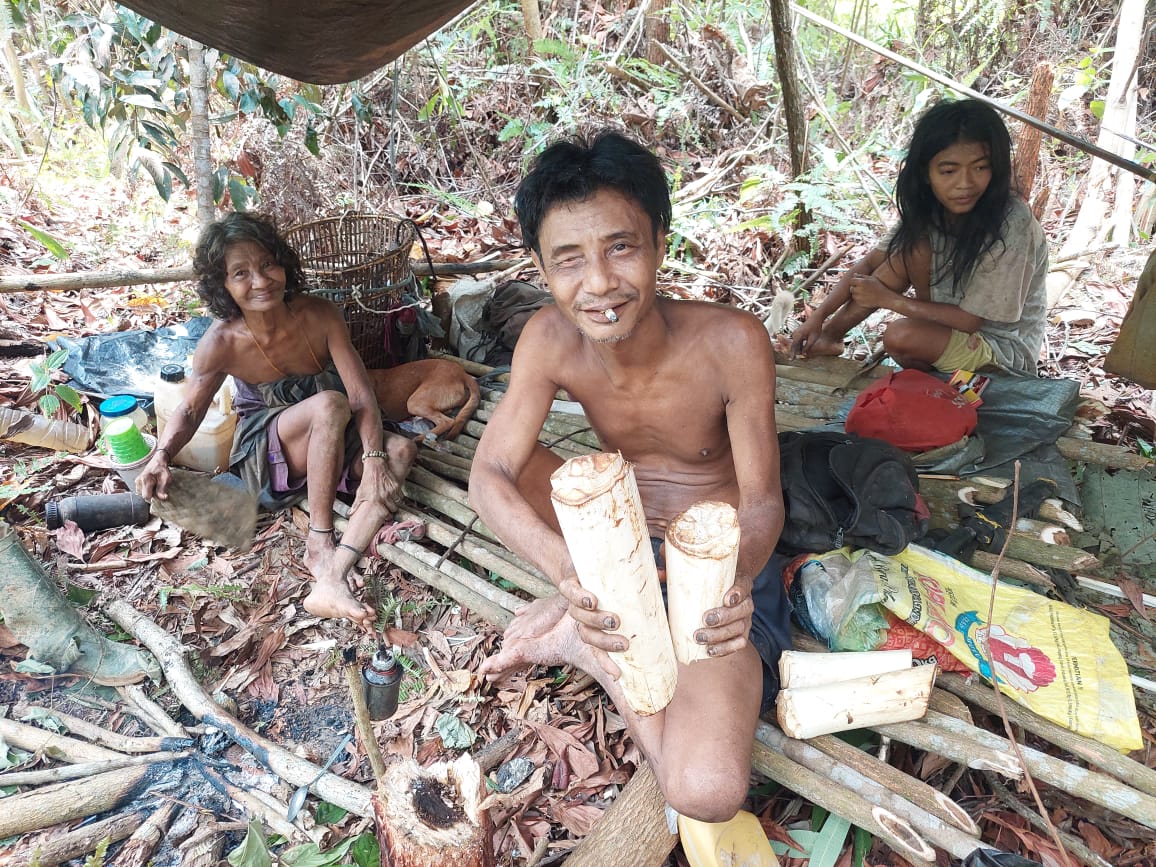Abstract
The Suku Anak Dalam (SAD) Batin Sembilan living in the Hutan Harapan area of Jambi Province has experienced socio-cultural dynamics resulting from the impacts of development and ecological changes of forest. The various interventions of extractive companies and others (Orang Terang) require them to learn new things that are absent in their knowledge system and traditional way of life. The present study is based on anthropological studies that rely on qualitative methods with a cultural ecology perspective aiming to describe the adaptive actions of SAD Batin Sembilan in responding to changes in their physical and socio-cultural environment as well as the reconstruction of their cognitive. The findings show that although they have long been in contact with people from outside the community, suggesting an influence on the way of thinking, living, and fulfilling their needs or livelihood, the SAD community seems to have preserved their socio-cultural identity closely associated with life dependence on forest. This study sheds new light on the actual picture of the SAD Batin Sembilan community in responding to changes.
References
Abdullah, I. (2015). Konstruksi dan Reproduksi Kebudayaan Yogyakarta. In Pustaka Pelajar.
Ahimsa-Putra, H. S. (1994). Antropologi Ekologi: Beberapa Teori dan Perkembangannya. Masyarakat Indonesia, 20(4), 1–50.
Alland, J. (2003). Adaptation. Annual Review of Anthropology, 4, 59–73. https://doi.org/10.1146/annurev.an.04.100175.000423
Andaya, B. W. (1993). To Live As Brothers. In University of Hawai Press. University of Hawai Press. https://doi.org/10.1515/9780824847265
Anwar, H., Hanana, A., & Pujiraharjo, S. (2022). Intervensi Medis Modern Terhadap Kehidupan Suku Anak Dalam (Kasus Batin Sembilan Di Hutan Harapan). Pangadereng : Jurnal Hasil Penelitian Ilmu Sosial Dan Humaniora, 8(1), 101–121. https://doi.org/10.36869/pjhpish.v8i1.229
Bennett, J. W. (1944). The Interaction of Culture and Environment in the Smaller Societies. American Anthropologist, 46(4). https://doi.org/10.1525/aa.1944.46.4.02a00040
Bennett, J. W. (2017). The Ecological Transition: Cultural Anthropology and Human Adaptation. In The Ecological Transition: Cultural Anthropology and Human Adaptation. https://doi.org/10.4324/9781351304726
Buergin, R. (2016). Ecosystem Restoration Concessions in Indonesia: Conflicts and Discourses. Critical Asian Studies, 48, 278–301. https://doi.org/10.1080/14672715.2016.1164017
Creswell, J. W. (2012). Research Design: Pendekatan Kuantitatif, Kualitatif,dan Mixed (Edisi Ketiga). Pustaka Pelajar.
Hein, J., & Faust, H. (2014). Conservation, REDD+ and the struggle for land in Jambi, Indonesia. Pacific Geographies, 41.
Hidayat, R. (2012). Membangkit Batang Terendam: Sejarah Asal Usul, Kebudayaan dan Perjuangan Hak SAD Batin 9. In Yayasan Setara Jambi. Yayasan Setara Jambi.
Hutan Harapan. (2020). Satu Dekade Pengelolaan Restorasi Ekosistem.
Indrizal, E. (2000). Mitos Orang Kalah: Orang Laut dan Pola Pemukimannya. Antropologi Indonesia, 61, 60–70.
Islahuddin, I., Eppang, B. M., Som, A. P. M., Masatip, A., & Salim, M. A. M. (2022). Adaptation and collaboration of local community in super priority destination tourism program in Labuan Bajo. Etnosia: Jurnal Etnografi Indonesia, 7(1), 15–28. https://doi.org/10.31947/etnosia.v7i1.19708
Jauhari, B. V., & Said, A. (2012). Jejak Peradaban Suku Anak Dalam. In Lembaga Swadaya Masyarakat Kelompok Suku Anak Dalam.
Kubitza, C., Krishna, V. v., Alamsyah, Z., & Qaim, M. (2018). The Economics Behind an Ecological Crisis: Livelihood Effects of Oil Palm Expansion in Sumatra, Indonesia. Human Ecology, 46(1), 107–116. https://doi.org/10.1007/s10745-017-9965-7
Kunz, Y., Steinebach, S., Dittrich, C., Hauser-Schäublin, B., Rosyani, I., Soetarto, E., & Faust, H. (2017). ‘The fridge in the forest’: Historical trajectories of land tenure regulations fostering landscape transformation in Jambi Province, Sumatra, Indonesia. Forest Policy and Economics, 81. https://doi.org/10.1016/j.forpol.2017.04.005
Li, T. M. (2020). Kisah dari Kebun Terakhir. Margin Kiri.
Li, T. M., & Semedi, P. (2021). Plantation Life: Corporate Occupation in Indonesia’s Oil Palm Zone. Duke University Press.
Manurung, B. (2013). Sokola Rimba: Pengalaman Belajar Bersama Orang Rimba (D. Yuniar, Ed.). INSISTPress.
Marcus, J. C., Sophie, C., Jonas, D., HEP, S., Vo Thai, D., & Villanueva. (2011). Oil palm Expansion in South East Asia: Trends and Implications for Local Communities and Indigenous Peoples (M. Colchester & S. Chao, Eds.; First). Perkumpulan Sawit Watch.
Marzali, A. (2018). Orang Rimba, Orang Batin, dan Orang Melayu di Jambi. Seminar Internasional Ke-3, Preserving Melayu Culture for Indonesia Integrity,”, 24–30.
Meggers, B. J. (1954). Environmental Limitation on the Development of Culture. American Anthropologist, 56(5). https://doi.org/10.1525/aa.1954.56.5.02a00060
Muntholib, S. (1995). Orang Rimbo: Kajian Struktural-Fungsional Masyarakat terasing di Makekal, Provinsi Jambi. In Bandung: Disertasi Universitas Padjadjaran Bandung.
Poerwanto, H. (2010). Kebudayaan dan Lingkungan Dalam Perspektif Antropologi. In Bab 1, Bab 2, Bab 3.
Prasetijo, A. (2011). Serah Jajah dan Perlawanan yang Tersisa - Etnografi Orang Rimba di Jambi. Penerbit Wedatama Widya Sastra.
Sandbukt, Ö., & Sandbukt, O. (1984). Kubu Conceptions of Reality. Asian Folklore Studies, 43(1). https://doi.org/10.2307/1178100
Spradley, J. P. (2007). Metode Etnografi, terj. Misbah Zulfa Elizabeth. Yogyakarta: Tiara Wacana.
Steinebach, S. (2017a). Farmers and Pawns: The Role of Migrants in Agrarian Conflicts and Rural Resistance in Sumatra, Indonesia. Asia Pacific Journal of Anthropology, 18(3), 228–245. https://doi.org/10.1080/14442213.2017.1304443
Steinebach, S. (2017b). “Today we Occupy the Plantation – Tomorrow Jakarta”: Indigeneity, Land and Oil Palm Plantations in Jambi. In Adat and Indigeneity in Indonesia. https://doi.org/10.4000/books.gup.170
Steward, J. H. (1955). Theory of Culture Change. University Illinois Press.
Sukmareni. (2015). Alam Sumatera, edisi Januari 2015. KKI Warsi.
Syuroh, M. (2011). Sosial dan Kebudayaan Kelompok Minoritas di Indonesia (Studi Kasus Kelompok “Batin Sembilan” di Provinsi Jambi). Masyarakat, Kebudayaan Dan Politik, 24(1), 17–23. http://journal.unair.ac.id/filerPDF/03_Mat Syuroh SOSIAL %26 KEBUDAYAAN _Revisi terbaru_ mda.pdf
Sze, J. S., Childs, D. Z., Carrasco, L. R., & Edwards, D. P. (2022). Indigenous lands in protected areas have high forest integrity across the tropics. Current Biology. https://doi.org/https://doi.org/10.1016/j.cub.2022.09.040

This work is licensed under a Creative Commons Attribution-NonCommercial 4.0 International License.
Copyright (c) 2023 ETNOSIA : Jurnal Etnografi Indonesia





